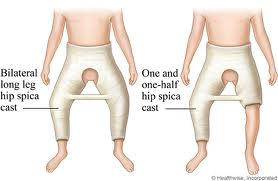Kara's right patella (knee cap) has been dislocating for years. We visited Kara's orthopedic surgeon years ago, and were made aware of a possible surgery to re-anchor the patella in place if her problems persist. Fortunately, her family is usually able to easily slide the patella back in place, so Kara's pain is usually brief.
On December 24, 2010, Kara's patella began dislocating multiple times a day. Her knee grew very swollen and we could not feel when it was in place. We visited the emergency room around 5:00 a.m. on December 26. The emergency room physician placed her entire right leg in a splint and said she should be fine to walk, but that she should see an orthopedic surgeon because surgery will most likely be necessary to keep the patella anchored permanently. Later that week we visited a local orthopedic surgeon and had her leg placed in an immobilizer until we could see her doctor at Stanford.
During the next three months, we witnessed several changes in Kara's behavior. She became lethargic, grew disinterested in her old obsessions, and spent nearly 24 hours a day sitting still in a chair. We also noticed that Kara stopped moving her left (non-injured) leg. She would keep it crossed at all times. This is atypical for her, because Kara is a kicker. She has kicked footrests off of her wheelchairs and kicked holes in cabinet doors.
On March 25, 2010, Kara, Jane and I went to Lucile Packard Children's Hospital at Stanford to receive the results of a recent CT scan and schedule her knee surgery. After explaining the symptoms of her left leg, a nurse practitioner ordered extra X-rays of her left hip, knee, and femur. Kara was not flexible enough to be held in the proper positions, and the X-ray technician seemed concerned with the images. He left several times to consult with a physician. After the X-rays, we waited in an examination room for a curiously long time. When we were finally greeted by the nurse practitioner, Kara's physician, and another physician - all with anxious demeanor - we knew something was wrong. The new X-rays showed that Kara's left hip has been dislocated for approximately three months. The physicians explained that she will need to have surgery to reset the joint as soon as possible. This surgery will include sawing pieces of her femur and pelvic bone so the femur will fit in the socket. Ligaments and tendons will have to be cut, and scar tissue removed.
Perhaps the most disconcerting piece of information was regarding Kara's recovery. Kara will have to wear a "spica cast" for at least 2 months. This is a cast that will begin at her waist and extend to her ankles, with an opening at the crotch. Her legs will be spread. Due to the cast, we will not be able to transport Kara in any of our vehicles, and will probably have to rent a converted van with a wheelchair lift. We will also need a special reclining wheelchair.
Although the next few months will definitely be challenging, we are optimistic that this will ultimately bring Kara much-needed comfort, and possibly lead to the restoration of her walking abilities some day.
